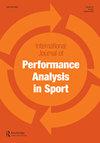Comparison of kinematic performance and analysis of the effect of punching speed of rear hook of college boxers of different sexes
IF 1.6
4区 教育学
Q2 SPORT SCIENCES
International Journal of Performance Analysis in Sport
Pub Date : 2023-10-03
DOI:10.1080/24748668.2023.2266326
引用次数: 0
Abstract
ABSTRACTThe paper aims to compare the kinematic performance of the rear hooks of college boxers of different sexes and analyse the influence of the kinematic indexes on punching speed. Thirteen kinematic indexes were selected to analyse the rear hook of male (n = 20) and female (n = 20) college boxers through a three-dimensional framework and high-speed camera. Additionally, a stepwise multiple linear regression equation was established to analyse the influence of these parameters on the maximum punching speed. The results revealed that the rear hook punching speed of college male boxers was 26% faster than that of female boxers. Also, there were statistically significant differences in the maximum angular velocity of the shoulder joint, hip joint angle, and knee joint angle (p < 0.01). In addition, the differences between their X- and Y-axis centre of gravity positions were statistically significant (p < 0.01). Moreover, the multiple regression analysis revealed that the maximum shoulder velocity was the most influential factor in the maximum punching speed of the rear hooks for both male and female boxers. This study provides recommendations for the daily training of college boxers and their coaches, to develop targeted training interventions for the rear hook.KEYWORDS: Combat sportsboxingbiomechanics Disclosure statementNo potential conflict of interest was reported by the author(s).不同性别大学生拳击手后钩运动性能比较及冲孔速度影响分析
摘要本文旨在比较不同性别大学生拳击手后勾拳的运动性能,分析运动学指标对出拳速度的影响。选取13项运动学指标,通过三维框架和高速摄像机对20名男、女大学生拳击手后钩进行分析。建立了逐步多元线性回归方程,分析了各参数对最大冲裁速度的影响。结果表明,高校男拳击手的后勾拳动作速度比女拳击手快26%。肩关节最大角速度、髋关节角度、膝关节角度差异有统计学意义(p < 0.01)。X、y轴重心位置差异有统计学意义(p < 0.01)。此外,多元回归分析显示,最大肩速是影响男女拳击手后钩最大出拳速度的最主要因素。本研究为高校拳击手及其教练员的日常训练提供建议,以制定有针对性的后勾拳训练干预措施。关键词:格斗运动拳击生物力学披露声明作者未报告潜在的利益冲突。
本文章由计算机程序翻译,如有差异,请以英文原文为准。
求助全文
约1分钟内获得全文
求助全文
来源期刊

International Journal of Performance Analysis in Sport
Health Professions-Physical Therapy, Sports Therapy and Rehabilitation
CiteScore
4.40
自引率
4.80%
发文量
38
期刊介绍:
The International Journal of Performance Analysis in Sport aims to present current original research into sports performance. In so doing, the journal contributes to our general knowledge of sports performance making findings available to a wide audience of academics and practitioners.
 求助内容:
求助内容: 应助结果提醒方式:
应助结果提醒方式:


